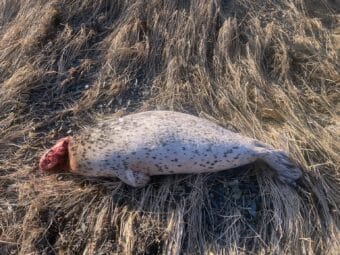
Perched below the viewing platform at the Alaska Raptor Rehabilitation Center, an eagle named Volta let out a high-pitched sound — almost like a laugh.
“That’s their territorial cackle,” said Richard Hart, the center’s development specialist. “It’s pretty much him saying, ‘That’s my spot, don’t try to take it from me.”
The center has been around for over 40 years, treating more than 200 injured birds annually.
“We started off in 1980. And it was actually just two gentlemen here in Sitka healing one bald eagle in their backyard,” Hart said. “And over years and years of work, it’s turned into what we have here today. And we are Alaska’s only full service avian hospital.”
Hart’s job at the Raptor Center is kind of a catch-all, but a big part of it is outreach on social media. They’re on all of the big platforms, like Facebook, Instagram and Twitter.
A few years ago, Hart began looking into a social media platform that was booming in popularity worldwide and was just about to catch on in the U.S. — Tiktok, a video-sharing app that was originally released in China in 2016.
“I read an article that was talking about how TikTok was getting close to a billion active users when it was still in India and China,” Hart said. “So of course, my reaction is ‘What social media site has almost a billion active users I’ve never heard of?’”
Hart downloaded TikTok and began to investigate.
“I quickly realized that within this landscape, there was a major piece missing — and it’s what we do,” Hart said. “It’s that educational, interesting side.”
Hart posted the first video in March of 2019, when dance videos were still the craze on TikTok.
“It was a lot of videos of our birds doing things, like doing a rouse with ‘Shake It Off’ sound,” he said. “It was sort of still in that dance aspect, but being done with birds. And then using the little parts of the bottom, the text, to be able to give little factoids about those birds.”
From treating injured hummingbirds in the ICU to releasing rehabilitated eagles, Hart shows TikTok users what the Raptor Center. And the app is making it possible to reach people all over the world.
“It’s definitely a younger audience, or people that really haven’t been exposed to the world that we are in here at the Raptor Center,” Hart said. “Which is one of the really cool things because a lot of the times some of the questions that we get asked on there are questions I’ve never been asked.”
One of the most recent videos to make a big impression: A great horned owl named Clackers, who wasn’t too happy about taking a trip to the bird doctor.
“When Clackers first came in, we opened up the front cage to his kennel, and he was in the back, and he just went, ‘Click, click, click, click, click, click click,’” Hart said. “And I happened to get a perfect little video of it.”
According to Hart, the format — short videos, catchy music — is a palatable package for educational content. It’s not surprising that the Raptor Center’s content dovetails with overall trends on TikTok, and views are taking off.
“Earlier today, we had a video of a sharp-shinned hawk that was released. And so I got to spend some time in the different comments explaining sharp-shinned hawks being exhibitors versus buteos, which are two different types of hawk species,” Hart said.
“It’s just fun to be able to have this cute little video that then turns into an educational lesson,” Hart continued. “It’s kind of a surprise. I want them to not realize they’re learning something.”
Since opening the Tiktok account in 2019, the Raptor Center has gained over 163,000 followers from all over the world.



